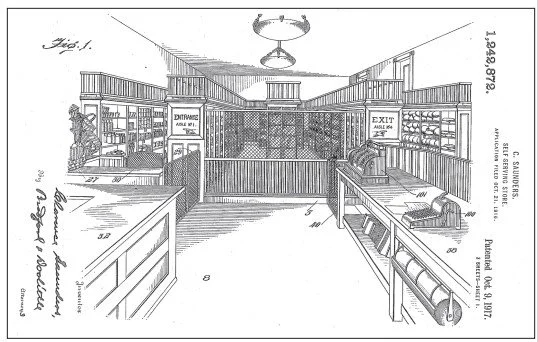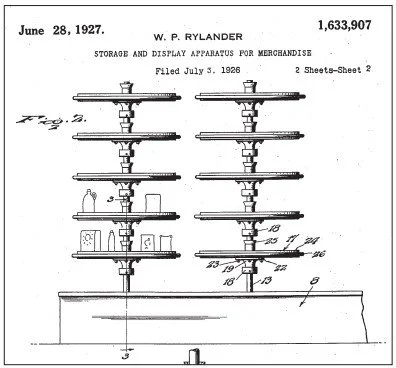Dozens of Self-Service Stores were patented as machines for automatic selling before 1940.
During the experimental phase of invention in the 1920s and 1930s, there were lots of different self-service store arrangements but whether they used conveyor belts, turntables, monorails, or market baskets they were all recognized as self-service stores. Only a few self-service stores were ever patented, but store patents offer important evidence of the design logic of their inventors. They document a wide variety of challenges for automating retailing and demonstrate some shared underlying principles that defined self-service stores as a distinctive store type.
Explore Store Patents
Shared Principles
At first glance there doesn’t seem to be much in common between a vehicle store and a zigzag store design, but store patents document some principles that defined self-service stores as a distinctive store type. They all are designed to articulate shopping pathways. They represent compartmentalized spaces with controlled entry and exit. They experiment with different strategies for mobilizing merchandise. They used sensory retailing strategies to automate salesmanship.
Patenting Pathways
Store patents all include floorplans that document how the store arrangement was designed as a connected system for automatic selling. Arrows indicate the intended pathway customers were supposed to take through the store space.
Compartmentalization
Self-service store designers used turnstiles or gates to control entry and exit, not just because they wanted to prevent theft. Store spaces were designed as self-contained systems with pathways that were designed to maximize sales. Turnstiles ensured that customers started and ended their shopping journey at the right point so that the system worked as intended.
Mobilizing Merchandise
Some of the wackiest design ideas involved attempts to mobilize merchandise using conveyor belts, turntables, monorails, and even automobiles.
Sensory Retailing
Self-service systems were designed to automate salesmanship using sensory retailing methods for focusing customer attention and generating desire to sell more stuff.








